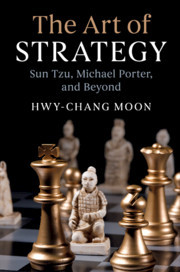Description
The Art of Strategy
Sun Tzu, Michael Porter, and Beyond
Author: Moon Hwy-Chang
A novel integration and extension of two global strategy classics: Sun Tzu's military strategy and Michael Porter's business strategy.
Language: English
Subject for The Art of Strategy:
Approximative price 92.80 €
In Print (Delivery period: 14 days).
Add to cart
The Art of Strategy
Publication date: 08-2018
332 p. · 15.7x23.5 cm · Hardback
Publication date: 08-2018
332 p. · 15.7x23.5 cm · Hardback
Approximative price 28.98 €
In Print (Delivery period: 14 days).
Add to cart
The Art of Strategy
Publication date: 08-2018
332 p. · 15x22.7 cm · Paperback
Publication date: 08-2018
332 p. · 15x22.7 cm · Paperback
Description
/li>Contents
/li>Biography
/li>
When it comes to strategy, how should we define victory? For centuries, Eastern and Western thinkers have grappled with this question, offering different answers. What can we learn from this difference? In The Art of Strategy, Moon provides a novel and systematic integration of the two dominant frameworks of the East and West: Sun Tzu's military strategy and Michael Porter's business strategy. This unlikely combination of thinking suggests an innovative extension of our understanding and practice of strategy, which will appeal to scholars, students, practitioners and general readers with an interest in strategy. By aligning the perspectives of these two great thinkers, Moon argues that true winning is about maximizing and optimizing overall value for all engaged stakeholders, and this requires a more efficient approach to strategy.
Introduction; 1. Getting started: overall assessment; 1.1. Sun Tzu: five elements for laying plans; 1.2. Porter: diamond model for analyzing competitiveness; 1.3. The integration of Sun Tzu and Porter; 1.4. Military case: Japanese attack on Pearl Harbor; 1.5. Business case: Sony's experience with the Walkman; 1.6. Conclusion and implications; 2. Economic consideration; 2.1. Sun Tzu: swift victory and local procurement in waging war; 2.2 Porter: value chain analysis in aligning activities; 2.3. The integration of Sun Tzu and Porter; 2.4. Military case: Napoleon's invasion of Russia; 2.5. Business case: Hyundai Motor's global strategy; 2.6. Conclusion and implications; 3. Avoiding competition; 3.1. Sun Tzu: complete victory by strategic attack; 3.2. Porter: five forces model for selecting the most attractive industry; 3.3. The integration of Sun Tzu and Porter; 3.4. Military case: Genghis Khan's terror strategy; 3.5. Business case: the changing attractiveness of the mobile phone industry; 3.6. Conclusion and implications; 4. Competitive positioning; 4.1. Sun Tzu: easy victory through tactical positioning; 4.2. Porter: generic strategy for advantageous positioning; 4.3. The integration of Sun Tzu and Porter; 4.4. Military case: Soviet's victory in the Battle of Stalingrad; 4.5. Business case: Toyota's changing position in automobile industry; 4.6. Conclusion and implications; 5. Enhanced advantage; 5.1. Sun Tzu: synergies from the combination of Cheng (Normal) and Chi (Abnormal); 5.2. Distinguishing operational effectiveness (OE) and strategic positioning (SP); 5.3. The integration of Sun Tzu and Porter; 5.4. Military case: the US failure in the Vietnam War; 5.5. Business case: Walmart's cost leadership strategy; 5.6. Conclusion and implications; 6. Unique positioning; 6.1. Sun Tzu: avoiding enemy's strengths and attacking their weaknesses; 6.2. Porter: choosing trade-offs for strategic fit; 6.3. The integration of Sun Tzu and Porter; 6.4. Military case: Hannibal's victory at Cannae; 6.5. Business case: Southwest Airlines' unique positioning; 6.6. Conclusion and implication; 7. Overcoming disadvantages; 7.1. Sun Tzu: turning the devious (disadvantage) into the direct (advantage); 7.2. Porter: turning corporate social responsibility (CSR) to creating shared value (CSV); 7.3. The integration of Sun Tzu and Porter; 7.4. Military case: the long march of the Red Army; 7.5. Business case: Nestlé's CSV activities in India; 7.6. Conclusion and implications; 8. Strategic flexibility; 8.1. Sun Tzu: variation of tactics; 8.2. Porter: consistency and changes in business strategy; 8.3. The integration of Sun Tzu and Porter; 8.4. Military case: the victory of the Greeks in the Trojan War; 8.5. Business case: Haier's successful transition through changes in its business strategy; 8.6. Conclusion and implications; 9. Extended strategies; 9.1 Sun Tzu: troop deployment and enemy investigation; 9.2. Porter: extended generic strategies; 9.3. The Integration of Sun Tzu and Porter; 9.4. Military case: Han Xin's victory in the Battle of Jingxing; 9.5. Business case: Tata Motor's failure in Tata Nano; 9.6. Conclusion and implications; 10. Location advantage; 10.1. Sun Tzu: exploitation of the terrain advantages; 10.2. Porter: cluster development for improving location advantage; 10.3. The integration of Sun Tzu and Porter; 10.4. Military case: Admiral Yi's victory in the Battle of Myeongnyang; 10.5. Business case: the competitiveness of Silicon Valley; 10.6. Conclusion and implications; 11. International strategy; 11.1. Sun Tzu: expeditionary strategy in the enemy territory; 11.2. Porter: configuration-coordination model for firms' internationalization; 11.3. The integration of Sun Tzu and Porter; 11.4. Military case: the UN Forces' victory in the Battle of Incheon; 11.5. Business case: Starbucks' success in China; 11.6. Conclusion and implicati
Hwy-Chang Moon is Professor at the Graduate School of International Studies, Seoul National University. Dr Moon has consulted many Korean and multinational companies, international organizations (e.g. UNCTAD) and governments (e.g. Korea, Malaysia, Dubai, Azerbaijan, Guangdong Province of China, and India). He has published numerous articles and books on topics covering International Business Strategy and Economic Development, including The Strategy for Korea's Economic Success (2016).
© 2024 LAVOISIER S.A.S.
These books may interest you

Finance and Strategy Inside China 105.49 €



